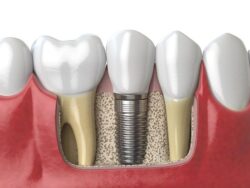About half of the adults in the United States will contract gum disease. This common infection of the gum tissue usually presents with inflammation in the gums, but it can progress to deteriorate the teeth and jawbone over time.
As a result of this extensive damage from advanced periodontal disease, the infection is known as the leading cause of tooth loss. A dentist can treat gum disease, but after eradicating the infection, how will your dentist replace lost teeth?
Tooth replacement treatments will depend on the extent of damage to your smile in the wake of gum disease. Your dentist can develop an individualized plan based on your unique oral health needs. But you can read to learn how gum disease impacts your eligibility for comprehensive tooth replacement.

How Does Gum Disease Lead to Missing Teeth?
Gum disease occurs when natural oral bacteria reach the gum tissue and inflame the gums. You can feel soreness and see bleeding in the gums during the early stage of this infection. But without treatment from your dentist, the bacteria will spread down to the roots of the teeth and the bone in the jaw.
The bacteria will then eat away at these oral structures, degenerating them until the tooth can fall out of its socket. With this much damage, a dentist cannot place the tooth back into the socket successfully. And you can face further dental deterioration from the missing teeth, even if the dentist treats the gum disease.
Will Gums Support Dental Implants After Periodontal Therapy?
Dentists can help you get rid of gum disease with periodontal therapy. They will thoroughly clean your smile, specifically deep in the gum pockets, to remove excess bacteria with a method known as scaling and root planing.
If the infection persists, they may need to refer you to a specialist for more extensive treatments, like gum surgery. Though these efforts can get rid of the infection, they do not restore already damaged gum tissue.
So if your gums suffer too much structural damage, they might not be strong enough to sustain the comprehensive tooth replacement treatment of implant dentistry. The dental implant relies on surgically placing an anchor into the gums and jaw to support prosthetic teeth.
The anchor must fuse with the jawbone, and if too much bone or gum tissue is lost, the process cannot happen successfully. You will need to restore the health of the gums or find an alternative tooth replacement that might prove less effective.
How Do Dentists Restore Gum Health?
If you suffer from gum recession or damaged gum tissue following the treatment of periodontal disease, a dentist may need to refer you to a specialist to restore structure to the gums. Otherwise, you might not be eligible for dental implants to replace missing teeth.
The dental expert might suggest a gum graft to transfer tissue to the gums to rebuild strength in this part of the mouth. Once healed, the gums can be strong enough to sustain the implant fixture. Learn more when you schedule a dental consultation today.
